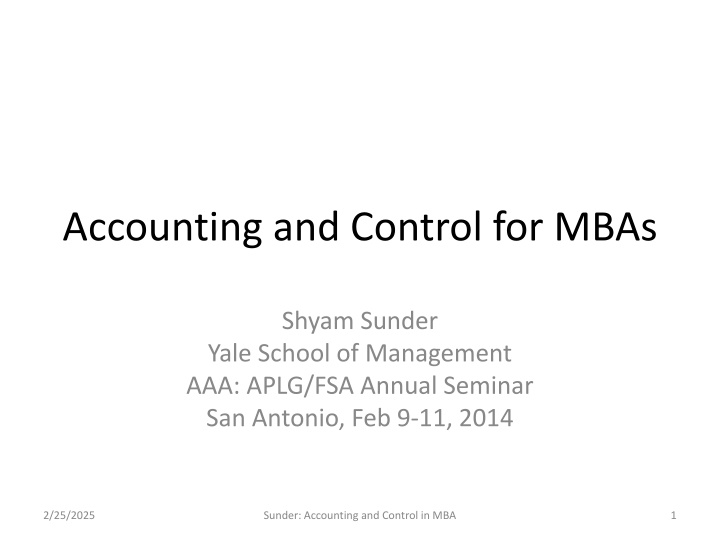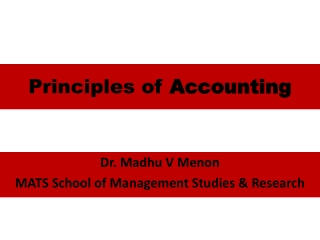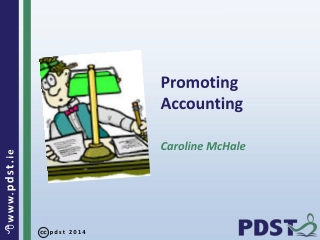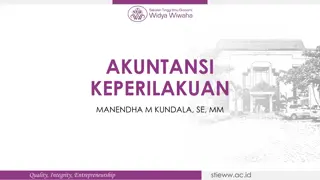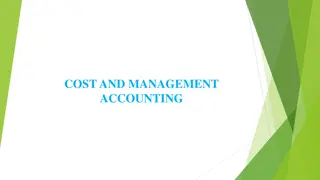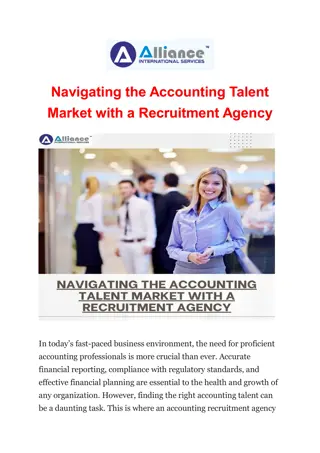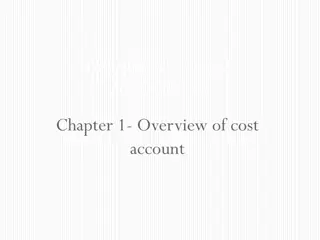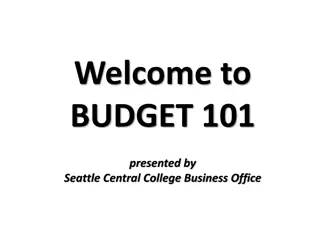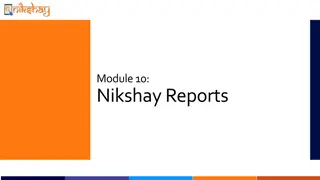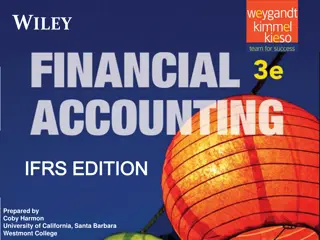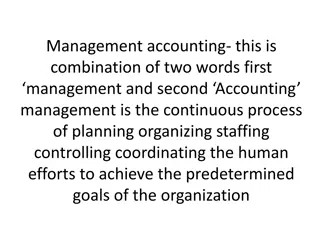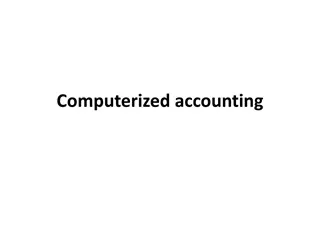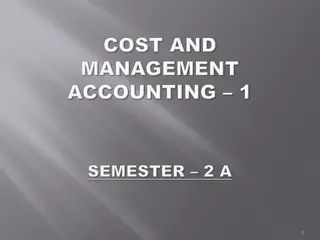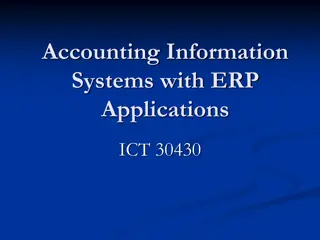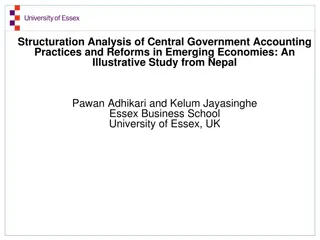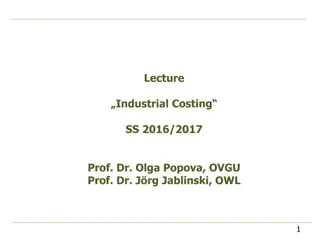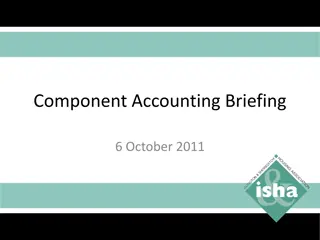Advanced Accounting Reports Overview
Essential accounting reports like Profit & Loss, Balance Sheet, Cash Reconciliation, General Journal, and more in C-Store Office Advanced Accounting. Understand the significance of each report and how they provide insight into the financial health of a business.
Download Presentation

Please find below an Image/Link to download the presentation.
The content on the website is provided AS IS for your information and personal use only. It may not be sold, licensed, or shared on other websites without obtaining consent from the author.If you encounter any issues during the download, it is possible that the publisher has removed the file from their server.
You are allowed to download the files provided on this website for personal or commercial use, subject to the condition that they are used lawfully. All files are the property of their respective owners.
The content on the website is provided AS IS for your information and personal use only. It may not be sold, licensed, or shared on other websites without obtaining consent from the author.
E N D
Presentation Transcript
Accounting and Control for MBAs Shyam Sunder Yale School of Management AAA: APLG/FSA Annual Seminar San Antonio, Feb 9-11, 2014 2/25/2025 Sunder: Accounting and Control in MBA 1
Accounting and Control and MBA MBA education to manage three overlapping levels of society: organizations, markets, and economy Data, information, contracts, and measurement process common to all aspects of management Sound education in A&C to understand, operate these processes, efficiently use their output, and adapt to changes in environment Explores the interfaces between management for business and society and A&C to facilitate thinking about the latter s role in the MBA curriculum. 2/25/2025 Sunder: Accounting and Control in MBA 2
A&C as Solving Problems of Managing Many think of A&C as a set of techniques or rules to generate the right answers A&C do use a collection of concepts, rules, and techniques; e.g., Assets, recognition, conservatism, and costing just as: NPV in finance, diversification is in investments, and throughput rate is in operations Too easy to lose sight of the problems of managing organizations, markets and economy that led to the development of these concepts and techniques over the millennia MBA education calls for understanding challenges of management, and ability to devise A&C systems to meet them Stereotypical perspective of accounting-as-a-mechanical-set-of- rules-of-bookkeeping fails to serve management education 2/25/2025 Sunder: Accounting and Control in MBA 3
Consequences of Failure This note identifies five basic functions of A&C in organizations, markets, and economy. Daily press reports of breakdowns of A&C, tragic and avoidable socio-economic consequences Inability or unwillingness of managers or policy makers to devise effective A&C Weak systems cynically manipulated for short term gains Such problems not just ethical, but are rooted in the failure to understand the function of A&C at various levels of society MBA education can be designed to emphasize the systemic role of, for example, budgeting, transparency, and public disclosure A&C calls for a careful balance between written rules and social norms, because no written rule can be evasion and manipulation proof. 2/25/2025 Sunder: Accounting and Control in MBA 4
Organization as a Set of Contracts among Participants Organizations business as well as non-business can be seen as sets of contracts among their participats Three broad classes of participats: from financial capital, labor (managerial as well as other), and product (input as well as output) markets All seek their own respective objectives through their participation in the organization; government and community constitute the fourth class of agents Set of contracts formal as well as informal expectations created in these relationships are defined as the organization. 2/25/2025 Sunder: Accounting and Control in MBA 5
Functions of Accounting and Control A&C as the operating system of the organization, essential for functioning Like the electrical or plumbing system of a building or the nervous system of an organism Five critical functions of accounting and control: 1. Monitoring and measuring resource inflows, 2. Monitoring and measuring resource outflows, 3. Determination and communication of contract fulfillment by various participants, and 4. Maintaining the liquidity of the capital, labor, and product markets by providing information to potential participants. 5. Provide common knowledge to facilitate contract renegotiation 2/25/2025 Sunder: Accounting and Control in MBA 6
Markets and Organizations The A&C system of an organization is designed to suit its structure and involvement with various markets Illustrate the point with three canonical organizational forms Proprietorship no managerial hierarchy (bookkeeping) Compactly owned with managerial hierarchy (managerial accounting incl. cost determination, profitability, budgeting, divisional and individual performance evaluation, and compensation schemes, etc.) Large firms with dispersed ownership: full form of financial reporting (all five functions of A & C) 2/25/2025 Sunder: Accounting and Control in MBA 7
1. Financial Reporting Model for Large Public Corporations A large part of A&C research and teaching in MBA programs concerns itself with this full-fledged financial accounting model (include internal controls, bookkeeping) Most developed form for most complex organizations, this model helps manage the organization s engagements with participants from capital, labor (managerial and other), and product (input and output) markets. In addition, its basic infrastructure serves to support the engagement of the organization with the government through tax accounting 2/25/2025 Sunder: Accounting and Control in MBA 8
MBAs must also Manage Entrepreneurial and Public Good Organizations Besides large publicly held corporations (producing private goods), MBAs have interest in the special features of entrepreneurships, partnerships, joint ventures, and re-organizations. Some 30-50 percent of the economy of most countries consists of organizations producing public goods mostly government and not-for- profit but also social enterprises as well as units of profit-oriented private good organizations that must be managed to produce public goods for use within the organization. The organizational economics of producing public goods calls for a different accounting, control, contract and governance system because the benefit of free monitoring of the output provided by paying customers in private good organizations is not as easily, frequently or quickly available in public good organizations. Instead of being the independent variable, the legal form of an organization is best seen as a variable that depends on the economic characteristic of its output e.g., private or public good, and how well the customer/beneficiary can assess its quality. 2/25/2025 Sunder: Accounting and Control in MBA 9
2. A&C and Markets in Large Public Corporations, A&C interact intensively with capital markets in myriad ways; need not dwell on them here Interacts with the managerial labor markets through costing, budgets, planning, transfer pricing, managerial and divisional performance, and compensation systems Engagement with others in the labor markets (payroll, benefits including pension system and their control problems) Interacts with customers through linkages between costing and pricing models of the firm, bidding estimates in contracting businesses, invoicing, trade credit, and debt collection Interaction with the suppliers includes control of quantities and quality of goods and services received before they are paid for. Many of these latter elements of the system do not receive much attention; like the plumbing or wiring; taken for granted; we hardly realize their importance until something goes wrong. 2/25/2025 Sunder: Accounting and Control in MBA 10
Maintaining Liquidity of Markets A&C system helps maintain the liquidity of capital, labor and product markets by providing verified information not only to the current security holders, employees, customers and suppliers but also by providing such information to others in each of these markets Others are potential participants No organization can continue to function for long without cultivating potential security holders, employees, customers, and suppliers by advertising to them through information channels. 2/25/2025 Sunder: Accounting and Control in MBA 11
3. A&C in the Economy at Large Taxation: Systems designed to minimize, control, estimate, and pay the taxes due to various government units along with support for resolution of disputes and litigation. Improved technology for planning and avoidance of taxation during the recent decades Management of Government organizations. Most but not all government units produce public goods. Absence of explicit pricing for public goods substitutes customers of private good organizations with beneficiaries of public good organizations Absence of price also eliminates the free benefit of monitoring of managerial and employee performance by paying customers (who can punish them by simply withholding revenue) This absence of monitoring by beneficiaries (who can complain, but cannot directly punish) has major implications for management, governance, and A&C of public good producing organizations Since a non-trivial number of MBAs work for public good organizations, they (and the society) would benefit from learning this fundamental economic difference and its organizational and managerial consequences. 2/25/2025 Sunder: Accounting and Control in MBA 12
A&C in the Economy Regulation: Since the second half of the nineteenth century in the U.S.A., state and federal regulation of gas, power, phone and other utilities, railroads, pipelines, securities, commodities and their exchanges, banks, insurance companies, brokerages and clearing houses, mutual funds, etc., Mostly based on their accounting data and reports. Antitrust Internal and external trade regulation and disputes (anti- dumping and hundreds of other national and international regulations and organizations) Over the past 75 years, regulation of financial reporting itself has become an important issue to which I return in the next section). 2/25/2025 Sunder: Accounting and Control in MBA 13
A&C in the Economy Public Policy and Law. Formulation, evaluation and implementation of public policy and law. (e.g., AHCA) Estimating the short and long-term financial consequences of draft legislation (behavior under the prevailing circumstances and after the proposal becomes law. OMB, CBO, state level agencies, CPAs and consultants Government Accountability Office (GAO) evaluates effectiveness of government programs in relation to the legislative intent, the money spent, and the results obtained. Civil and criminal litigation to implement laws often involves assessment of damages and penalties based on accounting data. Accrual of retirement and other benefits promised to the armed forces and other employees of federal, state, and local governments. E stimation and accrual of Social Security, Medicare, Medicaid, and comparable systems at state and local governments , overlap of accounting, economics, finance, politics, demography, and actuarial science. Inform Act, proposed in 2013, that requires the CBO, the GAO, and the OMB to do fiscal gap accounting and generational accounting on an annual basis, upon request by Congress, to use these accounting methods to evaluate fiscal legislation( http://www.theinformact.org/). 2/25/2025 Sunder: Accounting and Control in MBA 14
A&C in Macroeconomic Management Management of government organizations their accounting, budgeting and financial management system to ensure conformity to legislation is known more for violations than conformity with massive consequences of resource usage and efficiency. Many aspects of management of the economy by the executive branch of government and the central bank depend on accounting data. In the U.S., the Bureau of Economic Analysis depends on accounting data (and makes adjustments to it) to publish national income accounts which serve not only as a basis of managing the economy by the central bank and the executive branch but also decisions made in private organizations throughout the economy. 2/25/2025 Sunder: Accounting and Control in MBA 15
Accounting Policy Major failures in corporate and government accounting systems, and malfunctions at macroeconomic levels with severe consequences. Anticipated overhang of entitlement programs and pensions at federal, state and local levels in the U.S.A. and most other democratic countries is a matter of major public concern Political gridlock about spending and taxation policies Accounting for corporations, banks, governments, and regulation has not been without a role in these failures and difficulties. Understanding of the accounting linkages of these failures by the population at large, and even more so by the decision makers who make policy and run corporations and governments is a prerequisite for us to have a chance to have an intelligent resolution of the challenges before us so that we have a fair chance for a prosperous future. In addition to basic accounting literacy in the issues mentioned in the preceding sections, policy makers also need a basic understanding of the policy issues involved. I shall mention only two here. 2/25/2025 Sunder: Accounting and Control in MBA 16
Accounting Policy Auditing internal and external is an attempt to protect the integrity of A&C system from errors and opportunistic manipulation by the bosses. Weaknesses of human nature, millennia of efforts have found no perfect solution Every intervention brings its own side effects and unintended consequences A&C systems can bear only so much weight, breakdown under weight of temptation Consequences of high-powered incentives of managers and all-or-nothing games of politicians MBA education: awareness of limitations; of the so-called solutions (e.g., SOX, Dodd- Frank, and most recent proposal to rotate auditors). Written standards for financial reporting. writing down increasingly detailed rules over the eight decades of federal securities legislation has borne little fruit. Progressive shift from social norms (general accepted accounting principles or GAAP) Lawyers make critical decisions about accounting policy and legislation seem to think that writing clear rules should solve the problem; Such rules are a welcome invitation to financial engineers to evade the rules Better balance between social norms and written rules ; like common law and statutory law; MBA should know. 2/25/2025 Sunder: Accounting and Control in MBA 17
History and Technology The history of A&C, and management itself, as old as the problem of governing temples and kings finances First surviving European accounting textbook from 1492 (Pacioli sSumma in Latin), Kautilya s fourth century BCE Sanskrit classic on public management Arthasastra includes two detailed chapters on A&C. Extensive records of A&C throughout the Middle-East and China from several millennia. Yale s collections include not only the string quipus the Inca used to keep detailed accounts but also Sumerian cuneiform clay tablets showing evidence of double-entry bookkeeping in the third millennium BCE. Long history of efforts to develop A&C for various social, political, economic and technological situations in all parts of the world remains largely ignored by our fixation on accounting-as-bookkeeping. Development of computer technology and displacement of pen-and-paper bookkeeping systems by digital computing can give a superficial impression that accounting should no longer be an important element in MBA education At least some of our colleagues and many MBA students who may not have had the chance to reflect on the issues raised here may think so; based on equating accounting with bookkeeping. 2/25/2025 Sunder: Accounting and Control in MBA 18
A&C in MBA Curriculum Bookkeeping so perfected that most business managers and politicians never have to do it (most organisms live and die without knowing of their nervous system) MBA courses teach (and should teach) the students the Use of A&C for decisions in all aspect of organization, markets and economy Design of A&C systems to serve this goal efficiently Interactions as managers and policy makers with the A&C system Contrast with undergraduate curricula oriented to accounting professions. Both free standing and interlocking elements (with finance, human resources, macroeconomics, managerial economics, marketing, and operations, law, politics) Most of finance in the world of business is taught in courses labeled as accounting in business schools ( finance in business schools is called investments outside). Most recruitment for corporate finance jobs demands skills taught in accounting courses, absence of audit firms in CDO recruiting can easily leaves the impression that A&C is peripheral to MBA recruitment. Discuss this with the business deans! 2/25/2025 Sunder: Accounting and Control in MBA 19
Thank You! Shyam.sunder@yale.edu www.som.yale.edu\faculty\sunder 2/25/2025 Sunder: Accounting and Control in MBA 20
